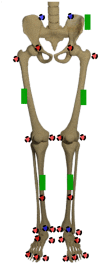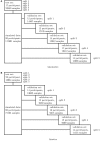Estimation of Gait Mechanics Based on Simulated and Measured IMU Data Using an Artificial Neural Network
- PMID: 32117923
- PMCID: PMC7013109
- DOI: 10.3389/fbioe.2020.00041
Estimation of Gait Mechanics Based on Simulated and Measured IMU Data Using an Artificial Neural Network
Abstract
Enhancement of activity is one major topic related to the aging society. Therefore, it is necessary to understand people's motion and identify possible risk factors during activity. Technology can be used to monitor motion patterns during daily life. Especially the use of artificial intelligence combined with wearable sensors can simplify measurement systems and might at some point replace the standard motion capturing using optical measurement technologies. Therefore, this study aims to analyze the estimation of 3D joint angles and joint moments of the lower limbs based on IMU data using a feedforward neural network. The dataset summarizes optical motion capture data of former studies and additional newly collected IMU data. Based on the optical data, the acceleration and angular rate of inertial sensors was simulated. The data was augmented by simulating different sensor positions and orientations. In this study, gait analysis was undertaken with 30 participants using a conventional motion capture set-up based on an optoelectronic system and force plates in parallel with a custom IMU system consisting of five sensors. A mean correlation coefficient of 0.85 for the joint angles and 0.95 for the joint moments was achieved. The RMSE for the joint angle prediction was smaller than 4.8° and the nRMSE for the joint moment prediction was below 13.0%. Especially in the sagittal motion plane good results could be achieved. As the measured dataset is rather small, data was synthesized to complement the measured data. The enlargement of the dataset improved the prediction of the joint angles. While size did not affect the joint moment prediction, the addition of noise to the dataset resulted in an improved prediction accuracy. This indicates that research on appropriate augmentation techniques for biomechanical data is useful to further improve machine learning applications.
Keywords: artificial neural networks; data simulation; inertial sensors; machine learning; motion analysis; wearable sensors.
Copyright © 2020 Mundt, Koeppe, David, Witter, Bamer, Potthast and Markert.
Figures











Similar articles
-
Prediction of lower limb joint angles and moments during gait using artificial neural networks.Med Biol Eng Comput. 2020 Jan;58(1):211-225. doi: 10.1007/s11517-019-02061-3. Epub 2019 Dec 11. Med Biol Eng Comput. 2020. PMID: 31823114
-
Prediction of Lower Extremity Multi-Joint Angles during Overground Walking by Using a Single IMU with a Low Frequency Based on an LSTM Recurrent Neural Network.Sensors (Basel). 2021 Dec 22;22(1):53. doi: 10.3390/s22010053. Sensors (Basel). 2021. PMID: 35009591 Free PMC article.
-
Estimation of Vertical Ground Reaction Forces and Sagittal Knee Kinematics During Running Using Three Inertial Sensors.Front Physiol. 2018 Mar 22;9:218. doi: 10.3389/fphys.2018.00218. eCollection 2018. Front Physiol. 2018. PMID: 29623042 Free PMC article.
-
Validation of wearable inertial sensor-based gait analysis system for measurement of spatiotemporal parameters and lower extremity joint kinematics in sagittal plane.Proc Inst Mech Eng H. 2022 May;236(5):686-696. doi: 10.1177/09544119211072971. Epub 2022 Jan 8. Proc Inst Mech Eng H. 2022. PMID: 35001713
-
Position paper on how technology for human motion analysis and relevant clinical applications have evolved over the past decades: Striking a balance between accuracy and convenience.Gait Posture. 2024 Sep;113:191-203. doi: 10.1016/j.gaitpost.2024.06.007. Epub 2024 Jun 13. Gait Posture. 2024. PMID: 38917666 Review.
Cited by
-
Human Activity Recognition for People with Knee Osteoarthritis-A Proof-of-Concept.Sensors (Basel). 2021 May 12;21(10):3381. doi: 10.3390/s21103381. Sensors (Basel). 2021. PMID: 34066265 Free PMC article.
-
Estimation of ground reaction force waveforms during fixed pace running outside the laboratory.Front Sports Act Living. 2023 Feb 13;5:974186. doi: 10.3389/fspor.2023.974186. eCollection 2023. Front Sports Act Living. 2023. PMID: 36860734 Free PMC article.
-
Kinect-Based Assessment of Lower Limbs during Gait in Post-Stroke Hemiplegic Patients: A Narrative Review.Sensors (Basel). 2022 Jun 29;22(13):4910. doi: 10.3390/s22134910. Sensors (Basel). 2022. PMID: 35808426 Free PMC article. Review.
-
Application of Machine Learning Methods to Investigate Joint Load in Agility on the Football Field: Creating the Model, Part I.Sensors (Basel). 2024 Jun 5;24(11):3652. doi: 10.3390/s24113652. Sensors (Basel). 2024. PMID: 38894442 Free PMC article.
-
Estimating Ground Reaction Forces from Gait Kinematics in Cerebral Palsy: A Convolutional Neural Network Approach.Ann Biomed Eng. 2025 Mar;53(3):634-643. doi: 10.1007/s10439-024-03658-y. Epub 2024 Nov 30. Ann Biomed Eng. 2025. PMID: 39616286
References
-
- Abadi M., Agarwal A., Barham P., Brevdo E., Chen Z., Citro C., et al. (2015). TensorFlow: Large-scale Machine Learning on Heterogeneous Systems. Available online at: tensorflow.org (accessed August 31, 2019).
-
- Ardestani M. M., Zhang X., Wang L., Lian Q., Liu Y., He J., et al. (2014). Human lower extremity joint moment prediction: a wavelet neural network approach. Exp. Syst. Appl. 41, 4422–4433. 10.1016/j.eswa.2013.11.003 - DOI
-
- Arlot S. and Celisse, A. (2010). A survey of cross-validation procedures for model selection. Statist. Surv. 4, 40–79. 10.1214/09-SS054 - DOI
-
- Atkinson K., Han W. (2009). Theoretical Numerical Analysis: A Functional Analysis Framework. New York, NY: Springer–Verlag.
LinkOut - more resources
Full Text Sources
Other Literature Sources
Research Materials

